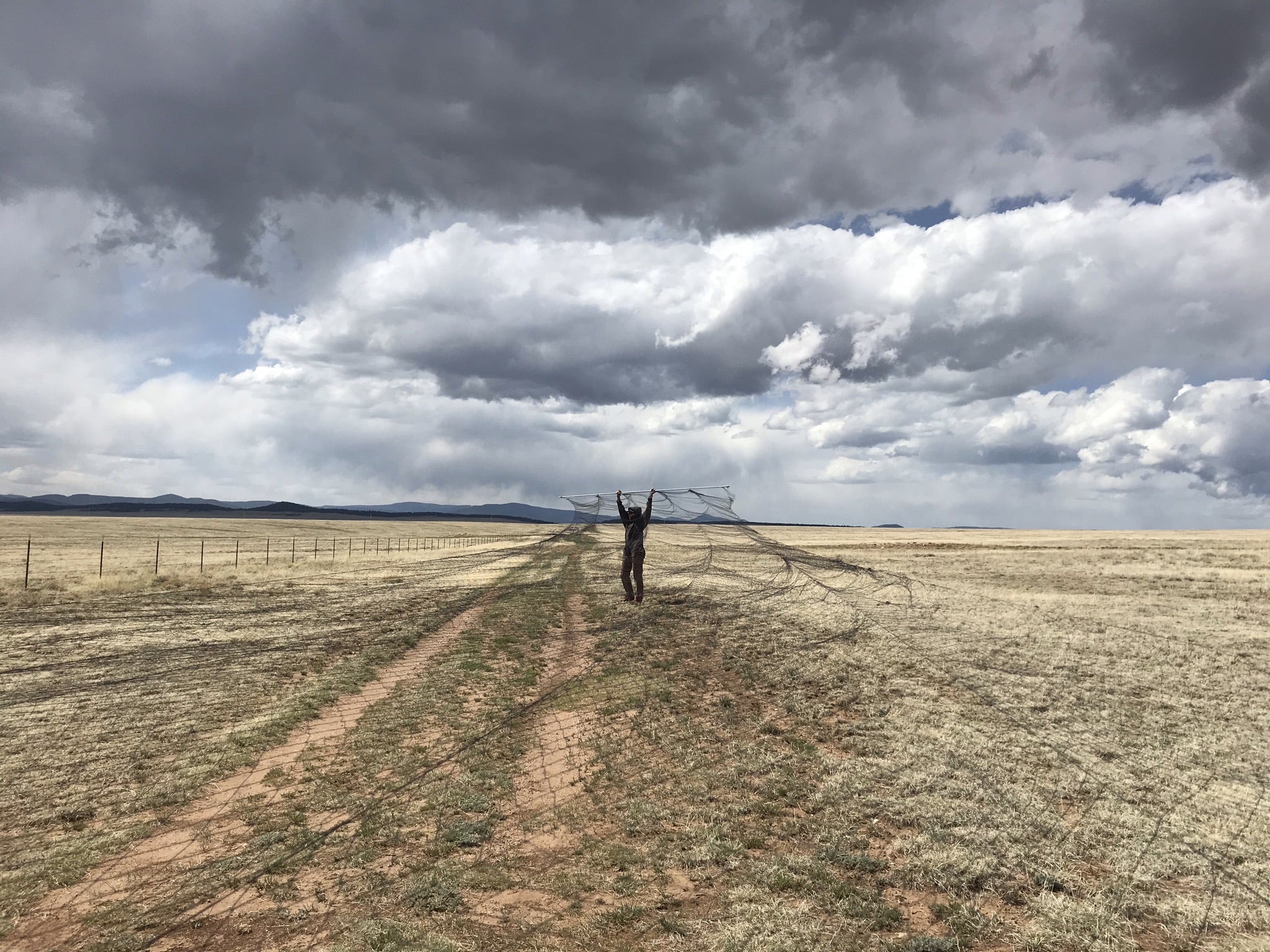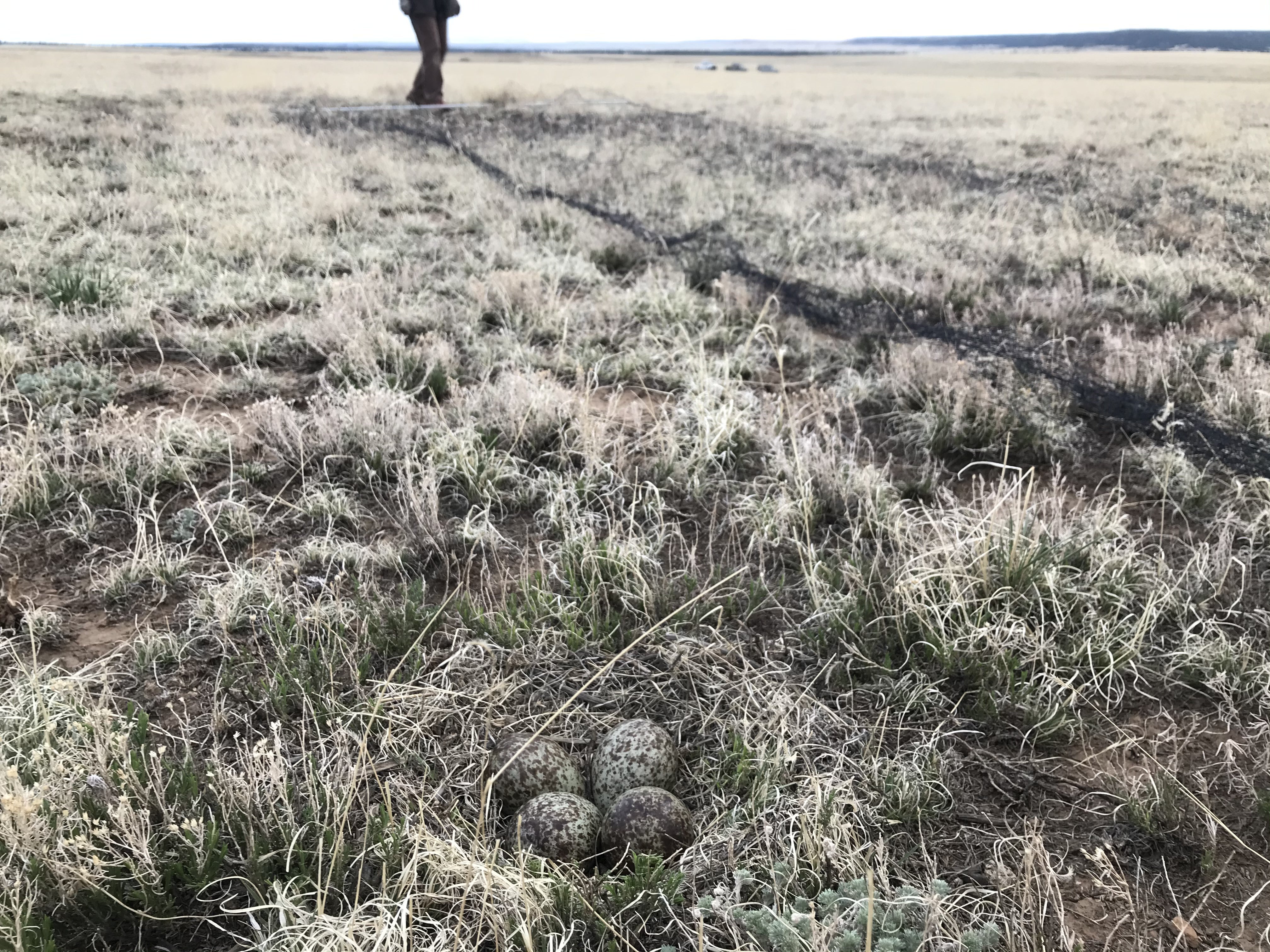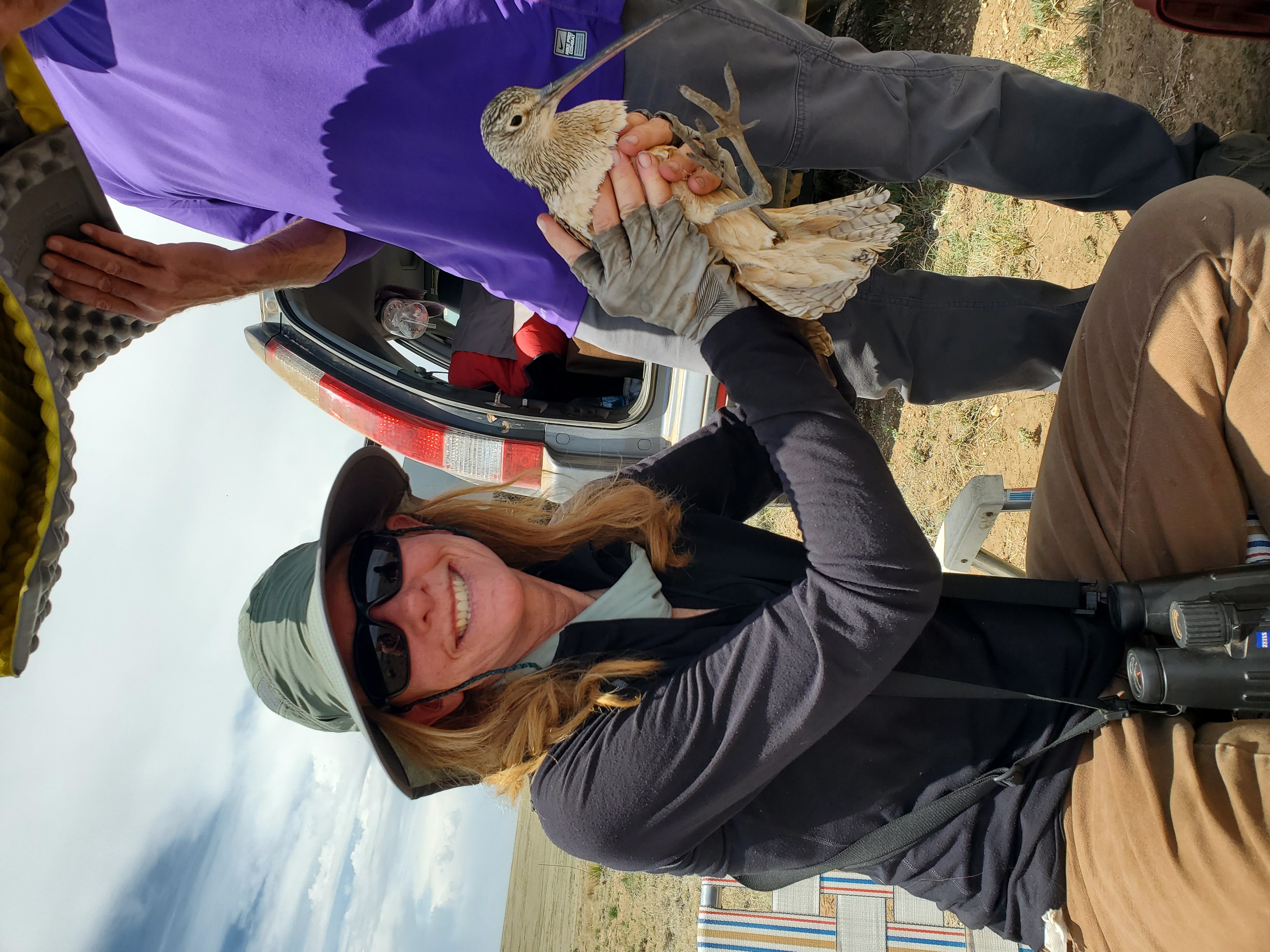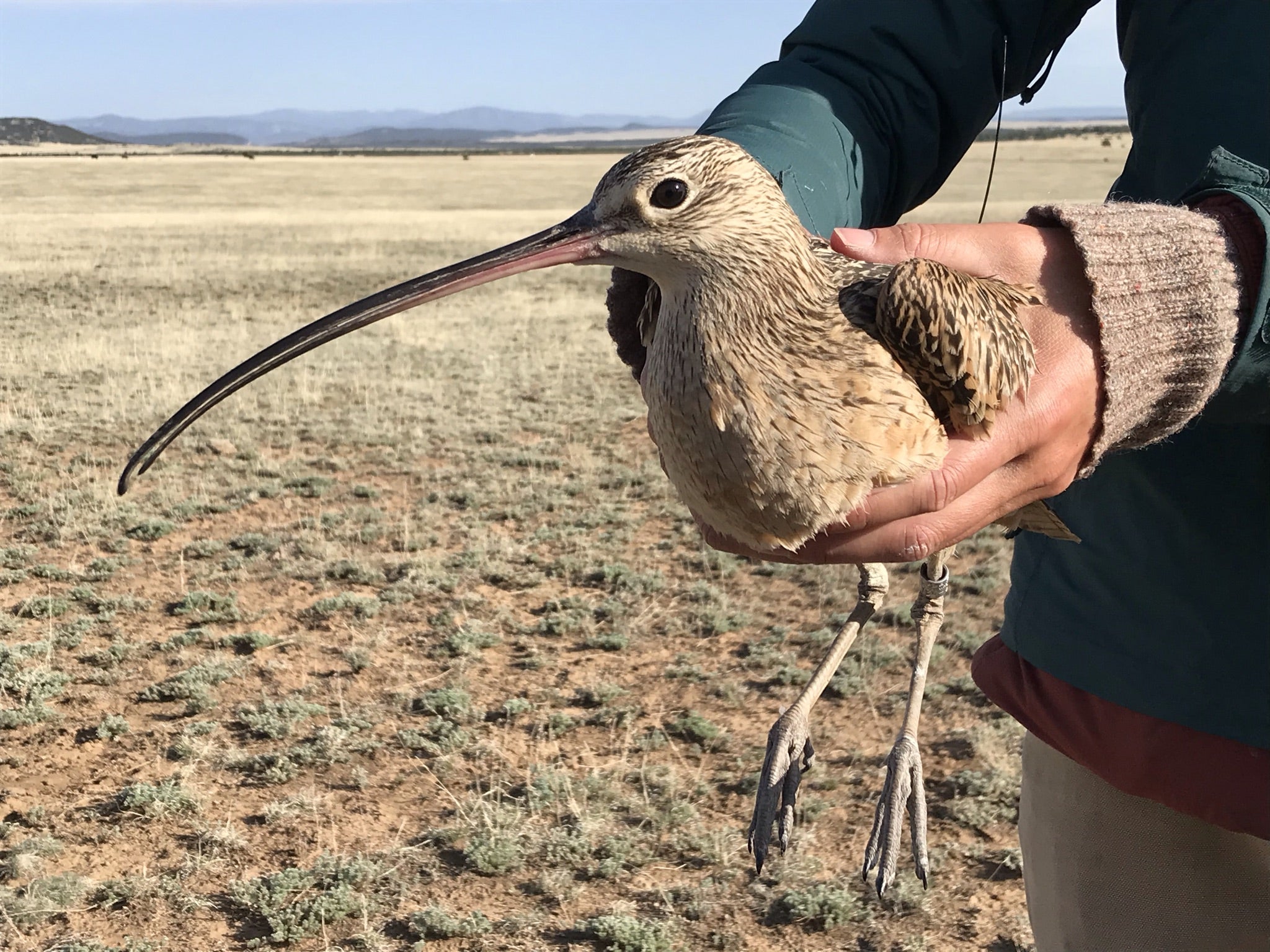By Stephanie Coates, IBO Research Biologist
Shortly after arriving at the Rio Mora National Wildlife Refuge (NWR) in New Mexico, we started our curlew capture odyssey with a windfall of nest discoveries. We found the first two before sunset just hours after I’d arrived, thanks to weeks of groundwork by partners at the U.S. Fish and Wildlife Service, New Mexico Department of Game and Fish (NMGF), a very dedicated volunteer, and a suite of supportive private landowners. With six satellite transmitters to attach to curlews in the plains of northcentral to northeast New Mexico, we anticipated it would take a week or less to find nests at the appropriate stage, capture six adult curlews on their nest, and fit each with a 9.5g transmitter. Oh, the fantasies we tell ourselves!

Capturing, if all goes well, is intense but straightforward.
I teamed with Kelli Stone, the shorebird/waterbird biologist for the Migratory Bird Program in the Fish and Wildlife Service’s Southwest Region, and Erin Duvuvuei, the Nongame Avian Biologist for NMGF. This core tagging crew was augmented by Ron Kellermueller from NMGF, Kristen Warren from the U.S. Forest Service on the Kiowa National Grasslands, and refuge staff and volunteers. To begin, two people carry an 18-meter long mist net, made for capturing birds, stretched between them and duct taped to metal conduit poles at the corners. A third person watches through a scope trained on the nest and directs the net team with an outstretched arm: straight up to tell the team they’re on the line, angled outward to show them the direction to move. Only, the director has a limited sense of distance when scanning across flat ground so it’s up to the net team to stay locked onto landmarks and watch for when the net is over the curlew.
Meanwhile, curlews sink their mottled brown heads and bodies earthward into their nest cups scraped into the soil, relying on camouflage and stillness to avoid detection. If the curlew stays, or “sticks”, on the nest, the capture process is forgiving. Many times, I’ve trapped a curlew after we’ve overshot and passed the net right over the bird, sometimes more than once in the same attempt. In New Mexico this time around, the curlews did anything but stick on the nest.
We had to use every capture opportunity we were given, but we could see some of the failed attempts coming. Like the time it was so foggy that to be visible Erin signaled directions with a collapsed camp chair rather than just her arm. Another time we arrived at a nest territory to find a very defensive, dive-bombing curlew, and a very nonchalant herd of bison milling about. Although we gave the curlew time to re-warm his clutch after the bison moved on, he flew up in defense mode when we were still tens of meters away. Once, we came so close that the edge of the net slid down the curlew’s back as he slipped off the nest.
For nearly every attempt the wind howled; whistling through the net, and whipping the dangling mesh.

We tried all the standard tricks: approaching the nest at different speeds, timing our captures well after the incubation switch time to avoid lingering antsy-ness, and silently communicating in pulls through the net like spiders feeling for prey. We traded jackets for better visibility of the director and more subdued hues for people at the net ends. Erin rolled the shiny new metal net poles in road ruts to coat them in dust. One afternoon I forced us into a holding pattern for more than an hour to ride out some ominous clouds and settle a pair of helicopter parent curlews. I wondered whether I should avoid making eye-contact with the incubating bird.
Our efforts took on a gleam of superstition.
Four days passed while we searched for nests in windy, cold, and sometimes unusually wet weather. After more than a dozen capture attempts, I marveled (let’s be frank: despaired) at how everything could be so seemingly flawless and yet we were empty handed.
Finally, the spell broke. We trapped “Chile Roja”, a female curlew with a nest on private lands just outside of Rio Mora NWR, carefully attached her transmitter, and breathed a collective sigh of relief as Kelli released her. After attaching a transmitter to another female, we drove to the Kiowa National Grasslands on the eastern New Mexico and Oklahoma border. Ideally, along with capturing a similar number of females as males, we also aim for a geographically diverse sampling of the curlew population. In a dry playa we spotted a nest by scanning “nesty looking” grass in the vicinity of a territorial male, and successfully caught the incubating female. Next, we found a nest just across a barbed wire fence, on private land. Fortunately, Kristen had joined us for efforts on the Grasslands, and she reached the landowner for permission. We strategically descended from the vantage point in a wide detour, crossing the fence well away from the nest to take the net set-up commotion away from the incubating curlew. Then we realized we’d run out of duct tape! We improvised, using our hair ties to secure the net to the poles. Once in place, we traversed the fence line, found our prickly pear cacti landmarks, and barely got the net down in time to capture her. Two to go.

We had been at it for seven days when we left the Kiowa Grasslands to return to Rio Mora NWR. Weary and dusty-eyed, we revised plans and decided to get some rest and try for a male early the next morning. When morning came, for the first time since I’d arrived, the air was still. Now at 20+ repeats of net setup, we moved quickly as the skies lightened and captured our first male curlew of the trip. Even after a re-fitting of the transmitter to ensure the straps weren’t too tight, there was still time before females were due to start their incubation shift. We looked at each other and Erin asked, “Do we try for the other male?”. We briskly packed our gear to the vantage point for Chile Roja’s nest. Through the scope, we could see her mate incubating. Kelli and I stretched out the net, and Erin raised her arm to direct.
We got closer and just as the net began passing over the curlew, I saw him shift to jump.
Usually I’m more of a “controlled net-lowering” person, but in that moment, I threw myself to the ground to bring the net down quickly. Curlew number six.
We had released the last curlew before 8:00am. These six curlews with transmitters would add to the five that Jay and much of the same team attached near the Rio Mora NWR in 2019. Tracking information like this comes with massive team effort, skill, and perseverance, and with the burden of individual curlews carrying transmitters, but informs conservation for the species in ways that other methods simply cannot. Elated and possibly delirious, we regrouped, and all admitted to the half-wish that there was another transmitter to go.

This article is part of our 2021 end of the year newsletter! View the full newsletter here, or click “older posts” to read the next article.
Make sure you don’t miss out on IBO news! Sign up to get our email updates.